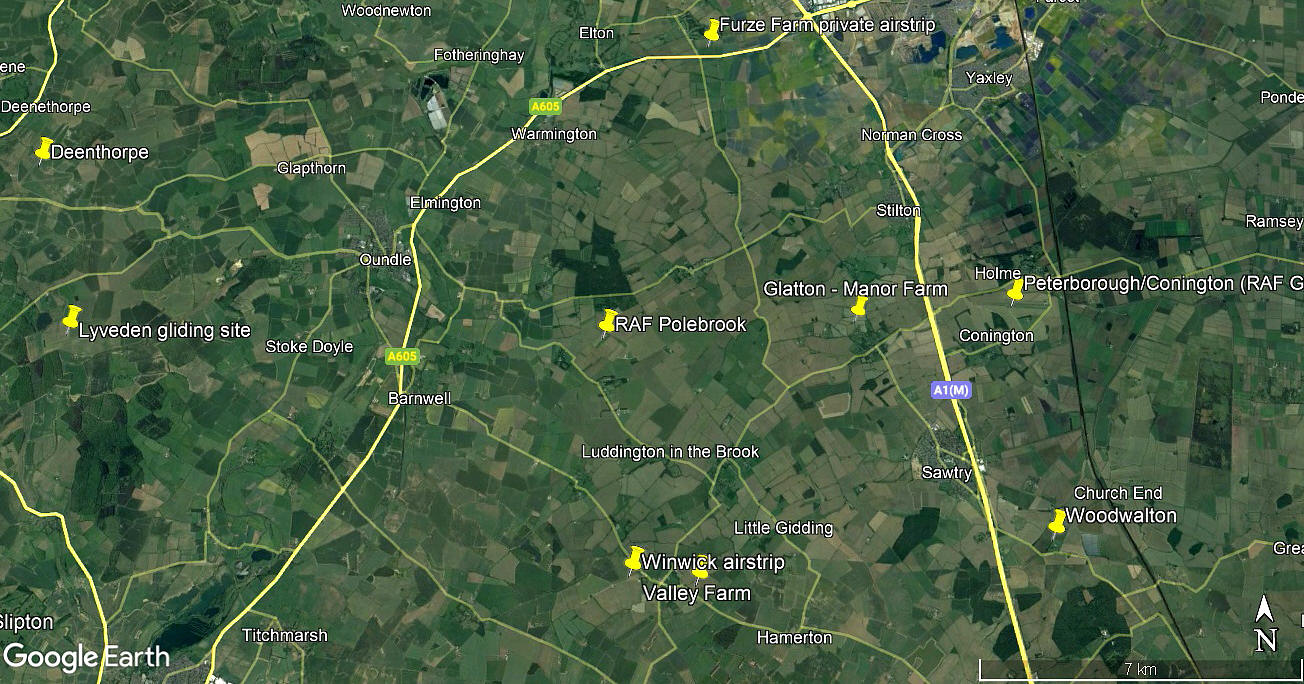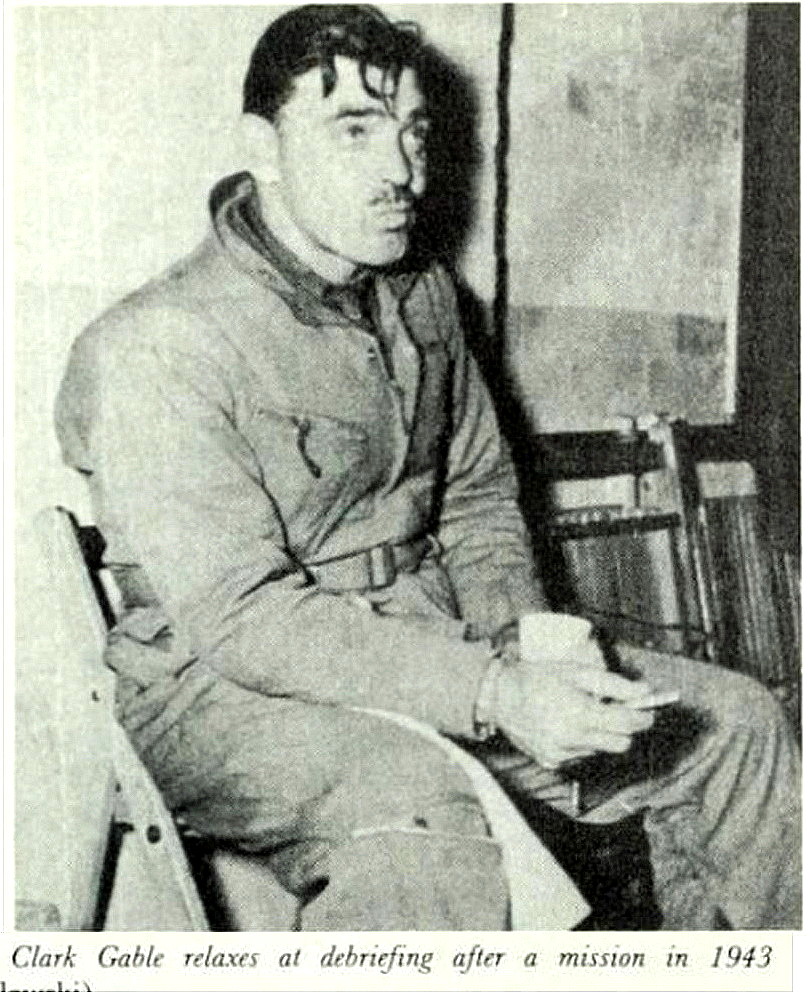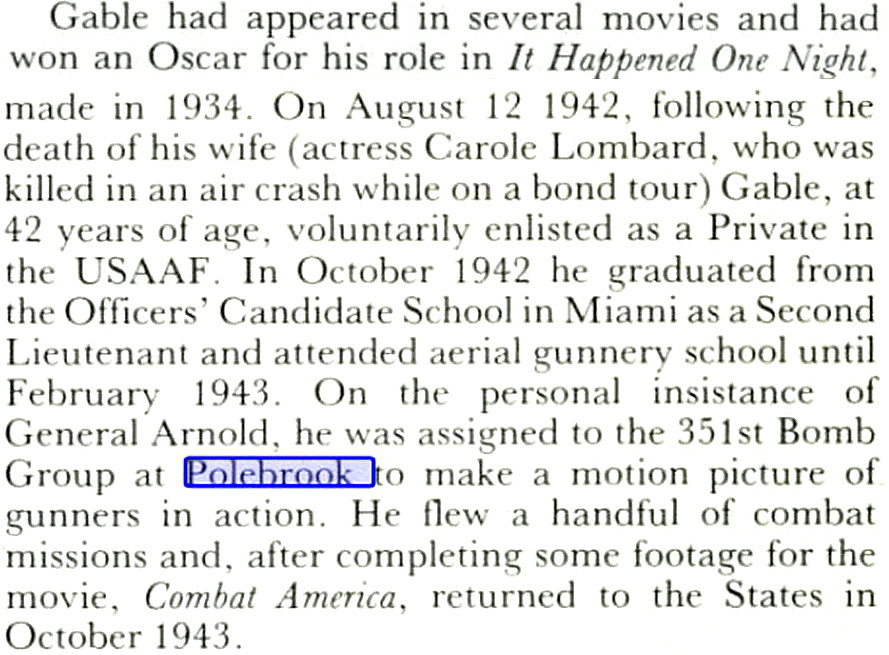Polebrook
POLEBROOK: Military aerodrome later gliding site
Note: These pictures are from my Google Earth © derived database. Quite unusually for such a large airfield in WW2, virtually nothing exists today.
Military users: WW2: Initially RAF Bomber Command
79 Sqdn (Handley Page Halifax)
90 Sqdn (Boeing B-17 Fortress Mk.1)
8th USAAF 94th Bombardment Wing (Station 110)
97th & 351st Bomb Group
408, 409, 410, 411 and 414th Sqdns (Boeing B-17 Flying Fortress)
Gliding: 1955 to 1958: Perkins Engines Gliding Club
Location: NNE of Hemington, 3nm ESE of Oundle
Period of operation: 1941 to 1963
Runways: WW2: 07/25 1783x46 hard 01/19 1280x46 hard
13/31 1280x46 hard
A MICHAEL T HOLDER GALLERY
Note: The airfield map is from the "Mighty Eighth War Manual" by Roger A Freeman. The picture and caption refers to a Halifax of 77 Squadron in May 1943.
THE CLARK GABLE INVOLVEMENT
During WW2 a couple of major film stars from the USA volunteered for war service in the USAAF. Were there others? The only other I have found who was actively involved in USAAF missions was Jimmy Stewart. Others such as David Niven, Mel Brooks, Kirk Douglas, Paul Newman, Jason Robards and Audrey Hepburn certainly helped to aid the war effort, but I'm not at all sure they became involved at the sharp end.
Note: The excerpt comes from 'Castles in the Air' by Martin W Bowman.
Note: The aerial photo is from 'Reddo's Raiders' by James J 'Reddo' Redmond. It appears to show, in the bottom left hand corner, the shadow of the B-17 seen flying low over the airfield. The partial view of the airfield is from 'Mighty Eighth War Manual' by Roger A Freeman.
SOME SUPER SLUETHING
The first picture is a scan from a postcard kindly sent to me by Mike Charlton. I had placed it in my article 'Sites to be identified', and there it sat for several years. Until March 2023 when Mike Holder spotted it and thought there was something about it that seemed familiar. Now then, take a close look and you will see part of the nose of a B-17 on the right hand side. Not much to go on to say the least.
However, Mike is not one to give up easily, so he had a long search around - and found it! It was in the book 'B-17 Flying Fortress Units' by Martin Bowman and this showed that the aircraft was the Boeing B-17E Flying Fortress, 41-9020, named 'Phyllis', taken in March 1942. This was then serving with 340 Squadron of the 97th Bomb Group, and the picture was taken here, at POLEBROOK.
At the risk of being nerdy, and this 'Guide' has made me starting to become somewhat 'nerdy', I noticed in the second picture that the converted bus was an AEC. Most probably built at the AEC works in Southall, west London. I have lived fairly nearby for many years and remember it well enough before it closed in 1979. The reason for mentioning it is that, although no expert, the pictures of USAAF bases in England during WW2, where vehicles appear - which is not often - seem to show that all the military vehicles on these bases are U.S. types. Which makes a lot of sense of course as they knew how to maintain them.
This said, the canteen 'bus' was being operated by the American Red Cross, so not a military vehicle. I'll bet there is somebody out there who can provide chapter and verse on this vehicle - but - I suspect they would not be reading this 'Guide'. Why should they? To end on an aviation note, AEC built the one-and-a-half decker buses used by BEA to ferry passengers to and from HEATHROW and the Waterloo Air Terminal, which also had a helipad. (See my listing). This was replaced in 1957 by the West London Air Terminal in Kensington. Known as the AEC Regal IV, BEA ordered 65 and they served from the early 1950s until the mid 1960s, (at least), being replaced by another fleet of 65 AEC Routemaster based coaches. These drew a trailer for the baggage and were built during 1966/67.
The West London Air Terminal was closed in January 1974, no doubt because the Heathrow extension of the Piccadilly Line tube service was due to open. Typically it was late in opening, in stages, between 1975 and 1977. Quite what passengers, not wanting a taxi service into central London, thought of this alternative to the comparative luxury of the coaches, appears unknown.
NOTES: It seems that two squadrons of B-17s, one from here plus another from GRAFTON UNDERWOOD in NORTHAMPTONSHIRE took place in the first raid by 8th Air Force heavy bombers in WW2 attacking the railway marshalling yards in Rouen, France in 1942.
SOMETHING TO CONSIDER?
1947 saw this airfield nigh on full of war-surplas Short Stirlings awaiting their fate, at the hands of scrap merchants. Considering that we were supposed to have “won” the war, or at least been on the winning side, doesn’t it seem a bit odd that nobody thought it worthwhile to save at least one of these very important types for posterity?
Why were so many people in the RAF High Command apparently hell-bent on destroying nearly every aircraft type they could lay their hands on to remove any material trace of RAF involvement in WW2? And yet it seems, quite happy to save types from the Nazi regime. A very odd situation - isn’t it?
A GREAT STORY
In late 2013 a good friend sent me a most amazing account of a USAAF B-17, the “All American”, serial number 1244406, the pilot being Ken Bragg Jnr, of the 414th Squadron being hit by a German fighter; very severely damaged but still flying. This might well be, amongst many others, the very best example of how a B.17 could survive horrendous battle damage and still keep flying. You can look this up on the internet. The story implies that the squadron was based in the UK. It wasn’t, it was then based at Biskra airfield in Algeria when the incident occurred, during a raid on Tunis, on the 1st February 1943.
The 414th Squadron of the 97th Bomb Group was briefly based here flying the Boeing B-17 Fortress from the 11th June to the 10th November 1942.
ANOTHER TRANSFORMATION
In 1959 POLEBROOK became a RAF Bomber Command ‘Thor’ IRBM missile base, disbanded in 1963.
We'd love to hear from you, so please scroll down to leave a comment!
Leave a comment ...
Copyright (c) UK Airfield Guide

































